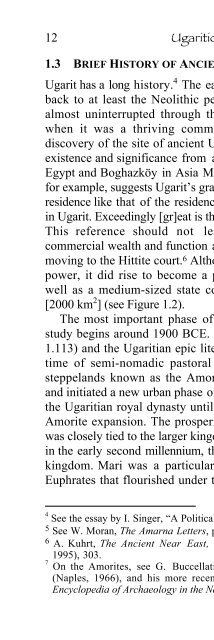A Primer on Ugaritic: Language, Culture, and Literature - enenuru
A Primer on Ugaritic: Language, Culture, and Literature - enenuru
A Primer on Ugaritic: Language, Culture, and Literature - enenuru
Create successful ePaper yourself
Turn your PDF publications into a flip-book with our unique Google optimized e-Paper software.
12<br />
<strong>Ugaritic</strong> <str<strong>on</strong>g>Primer</str<strong>on</strong>g><br />
1.3 BRIEF HISTORY OF ANCIENT UGARIT<br />
Ugarit has a l<strong>on</strong>g history. 4 The earliest settlement of the site dates<br />
back to at least the Neolithic period (6500 BCE) <strong>and</strong> c<strong>on</strong>tinues<br />
almost uninterrupted through the end of the Late Br<strong>on</strong>ze Age,<br />
when it was a thriving commercial center. Even before the<br />
discovery of the site of ancient Ugarit, scholars had known of its<br />
existence <strong>and</strong> significance from archives excavated in Amarna in<br />
Egypt <strong>and</strong> Boghazköy in Asia Minor. One of the Amarna Letters,<br />
for example, suggests Ugarit’s gr<strong>and</strong>eur: “Look, there is no mayor’s<br />
residence like that of the residence of Tyre. It is like the residence<br />
in Ugarit. Exceedingly [gr]eat is the wealth [i]n it” (EA 89:48–53). 5<br />
This reference should not lead <strong>on</strong>e to exaggerate Ugarit’s<br />
commercial wealth <strong>and</strong> functi<strong>on</strong> as an entrepôt for grain supplies<br />
moving to the Hittite court. 6 Although Ugarit never became a major<br />
power, it did rise to become a prosperous commercial center as<br />
well as a medium-sized state covering over 1,240 square miles<br />
[2000 km 2 ] (see Figure 1.2).<br />
The most important phase of Ugarit’s history for the present<br />
study begins around 1900 BCE. Both the <strong>Ugaritic</strong> king list (KTU<br />
1.113) <strong>and</strong> the Ugaritian epic literature point to the arrival at this<br />
time of semi-nomadic pastoral tribes from the Mesopotamian<br />
steppel<strong>and</strong>s known as the Amorites, who settled ancient Ugarit<br />
<strong>and</strong> initiated a new urban phase of its history. 7 The foundati<strong>on</strong>s of<br />
the Ugaritian royal dynasty until its destructi<strong>on</strong> are traced to this<br />
Amorite expansi<strong>on</strong>. The prosperity of ancient Ugarit at this time<br />
was closely tied to the larger kingdoms of the Near East; first Mari<br />
in the early sec<strong>on</strong>d millennium, then Egypt, <strong>and</strong> finally the Hittite<br />
kingdom. Mari was a particularly important site <strong>on</strong> the middle<br />
Euphrates that flourished under the Amorites in the early sec<strong>on</strong>d<br />
4 See the essay by I. Singer, “A Political History of Ugarit,” in HUS, 601–733.<br />
5 See W. Moran, The Amarna Letters, p.162. See also EA 1, 47, 54, 152.<br />
6 A. Kuhrt, The Ancient Near East, c. 3000–330 BC (L<strong>on</strong>d<strong>on</strong>/New York,<br />
1995), 303.<br />
7 On the Amorites, see G. Buccellati, The Amorites of the Ur III Period<br />
(Naples, 1966), <strong>and</strong> his more recent survey, “Amorites,” in The Oxford<br />
Encyclopedia of Archaeology in the Near East (Oxford, 1997), 107–11.


